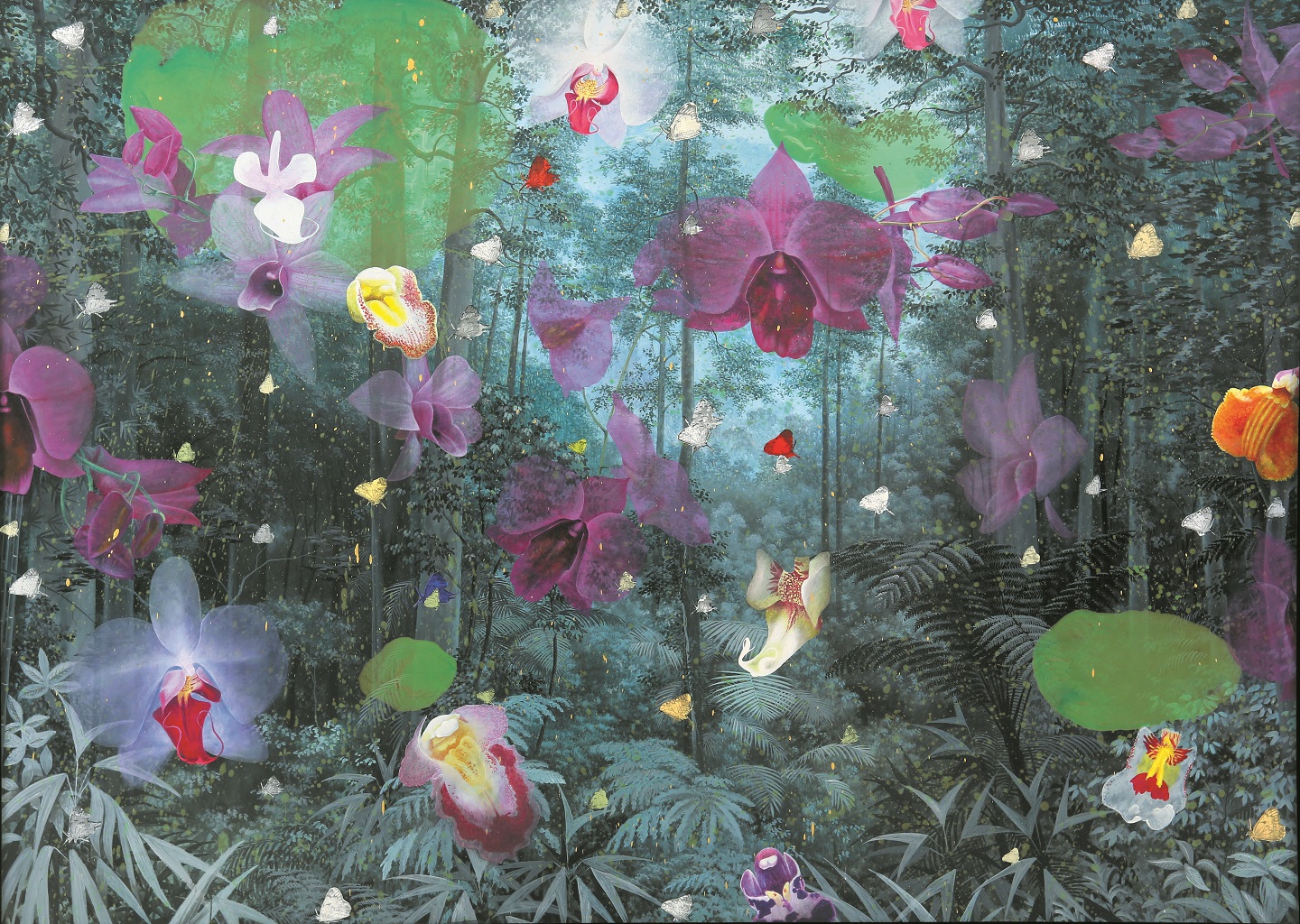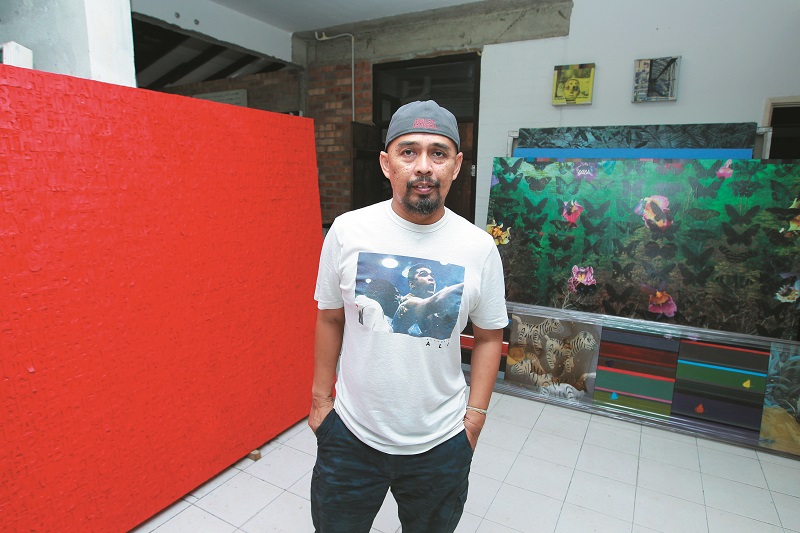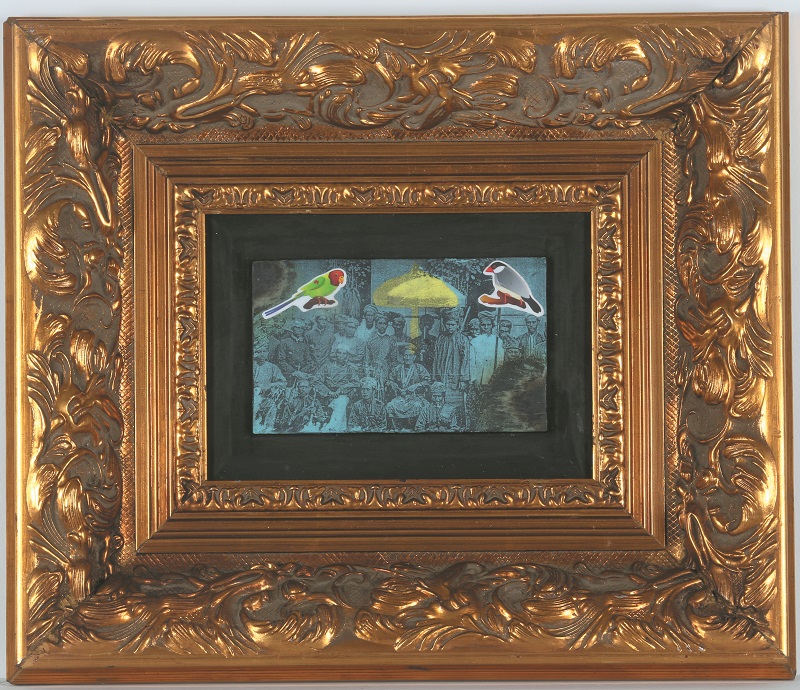
Having practised art professionally for over two decades, Ahmad Shukri Mohamed, 48, is showcasing 23 artworks in his eighth solo exhibition, titled Made in Malaysia: Works by Ahmad Shukri Mohamed from 2010 to 2017.
“The message I am trying to convey in Made in Malaysia is not about the Malaysian culture per se. Not in the sense of cultural commodity or things being made locally, but to illustrate the economic, social and political landscape of Malaysia since independence and how the country is projecting itself on the global front.

“As citizens, we want our nation to stay competitive with neighbouring countries like Singapore, Thailand, Indonesia and the Philippines,” says Shukri, who is a former member of Matahati, a collective formed in 1989, but disbanded in 2014. Its membership included other leading contemporary artists such as Bayu Utomo Radjikin, Ahmad Fuad Osman, Hamir Soib Mohamed and Masnoor Ramli Mahmud.
Apparent in Shukri’s artworks are subtle, symbolic images embedded within the lush rainforest landscapes of Golden Gate, which represent the environment, as well as tediously layered letters — canvas cut-outs, painted with oil and fixed onto canvas and presented in the form of a blackboard — as an allusion to the education system in Text.
The title of the exhibition aptly corresponds with recent events like the 29th SEA Games, which Malaysia hosted topped the medals table with 145 golds and the celebration of the country’s 60th year of independence on Aug 31 as well as Malaysia Day on Sept 16.
Text
In Text, Shukri offers viewers his visual interpretation of the political climate, reduced to a text and colour-only approach. It is pregnant with meaning, and one has to read between the lines to fathom his thoughts behind each work.
“The Text series goes beyond visual aesthetics. I want to highlight the importance of education, knowledge and the idea of understanding context. When we read a text, do we question ourselves and analyse further? Or do we merely read and accept what is written?” asks Shukri.
Daulat Tuanku — Raja Kami (Our King) a large mixed-media artwork measuring 213cm by 213cm, features canvas cut-out letters painted in black that are repetitively fixed onto the canvas in three layers to read “Daulat Tuanku”. A silhouette of the anonymous sultan is doodled in white chalk with the inscription, “Raja Kami — Our King”, above it.
“Daulat Tuanku represents the history of the Rukunegara, which was declared on Merdeka Day 1970, instituted by royal proclamation after the race riots of May 13, 1969. One of the duties of the Yang di-Pertuan Agong, as the head of Islam, is maintaining harmony in the country. It is a reminder to Gen Y, who seem to think history is unimportant,” says Shukri.
It is coincidental that the current Yang di-Pertuan Agong, Sultan Muhammad V, is the Sultan of Kelantan. Shukri was born in the state.
Happy Birthday Mao Zedong illustrates the silhouette of a historic event — the handshake between Tun Abdul Razak Hussein and Chairman Mao Zedong of China in 1974. In a similar fashion, the words “Happy Birthday Mao” are spelled out with cut-out letters, painted in bright red, and framed like a chalkboard with pieces of colourful chalks lined up at the bottom of the board.
“Forty-three years later, under the leadership of Tun Abdul Razak’s son, Prime Minister Datuk Seri Najib Razak, Malaysia is undergoing massive developments, such as the Forest City mega-project in Iskandar, Johor. This work represents our special relationship with one of the world’s superpowers, China,” says Shukri.
Two works, titled Made in China, Putrajaya — Beijing and Made in Malaysia, Putrajaya — Beijing depict a similar sentiment with another project, the East Coast Rail Link, which is set to cost US$13.1 billion. The agreement was signed by the government and state-owned China Communications Construction Company Ltd in November last year.

“The irony with history is that the world once opposed the communist ideology in China but now, we rely on that very nation for advancement in technology and for the development of our own country,” says Shukri.
Bersih — Jalur Gemilang suggests the cleansing of Malaysia in order to progress. Measuring 157.5cm by 157.5cm, the artwork is also laboriously composed of cut-out canvas letters, painted in black, with the word “bersih” (clean) repetitively and neatly spelled out all over the canvas. The fluttering Jalur Gemilang is outlined across the panel in white chalk.
“I don’t mean Bersih the political movement, but literally the meaning of the word itself, to clean everything that is damaging to our country. In the past, one would have to travel to learn about a new country. But today, with information technology, anyone from anywhere can learn about Malaysia without having to travel here. So, what do we want to project and how do we want to do so?” asks Shukri.
In Text, Shukri has incorporated the style of fabric collage and layering influenced by his mentor, Fauzan Omar, during Shukri’s apprenticeship with the artist and educationist in the early Nineties.
Golden Gate
The colossal scale of Garden of Heaven, which measures 208.4cm by 289cm, illustrates the beautiful rainforests of Malaysia. “The artworks in this exhibition not only portray current affairs — be it good or bad — but also highlight our country’s rich nature. Garden of Heaven signifies the perfection of the forest and the uniqueness of Malaysian flora and fauna,” says Shukri.
“Our country is rich in natural resour–ces — oil, gold, wildlife, unique species of flora. How can we manage and preserve these so we can maximise our resources but at the same time not destroy the environment?” he asks.
He uses the Malay idiom “marahkan nyamuk, kelambu dibakar” or “don’t throw the baby out with the bathwater” to encapsulate undesirable events that have occurred during our journey to progress, such as deforestation.
Illustrated in Land for Sale #1 is a rainforest landscape in the background with the profile of an astronaut on the right and an image of a rhinoceros on the left. At the bottom of the canvas is a collage of foreign currencies.
“I have incorporated foreign currencies like the pound sterling, Singapore dollar, renminbi and yen in this work to indicate the global economy and foreign investors in Malaysia,” says Shukri.
“Malaysia is also keen on space exploration, science and technology, but to achieve this, we have to be an educated nation.”
Postcards from Malaya and Made in Malaysia
Titled I Was Here, the images of 12 colonial postcards from the different states of Malaya are transferred onto wood and presented in a variety of gilded frames. Offered as a set, the artwork features nostalgic landscapes of Malaya — a kampung hut, coconut plantation, colonial buildings by the riverbank, wildlife images, a historic scene from Merdeka Day, and more. Shukri adds a touch of quirkiness by incorporating a colourful collage of birds into the artwork.

This series highlights Shukri’s ability to use printmaking techniques in his mixed-media approach to artmaking. His capacity to create extends beyond painting. Also featured as part of his artworks is the customised framing of works such as Kami yang Mengikut Perintah — Yes Boss from the Text series, I Was Here from Postcards from Malaya and the Made in Malaysia series.
A suite of nine watercolour paintings depicting events described in newspaper clippings are illustrated in a liberal manner in Made in Malaysia. Symbolic iconography, such as diamond shapes, silhouettes of handbags, luxury cars, armoured tanks, handcuffs, suicide vests and more represent some of the top stories published in local newspapers.
“One way for us to become a developed nation is to cleanse ourselves of negative criminal activities. For instance, in most developed countries, rarely will you read about petty news on the front pages of the newspapers — unlike in Malaysia, where the front pages often report crimes like bribery, theft, bullying, rape and so on.”
Each of these watercolours is presented in a unique way — every frame is lined with fabric, such as the traditional songket, which has been carefully selected by Shukri — with a label embroidered with the title of the exhibition, Made in Malaysia, attached to the artwork.
“I am only able to explore different modes of presenting or framing with Jinjit Station by Patisatu studio. It’s not a frame shop but an open studio where the public can come and express themselves creatively in a way that they understand. For instance, a collector of vintage toys may not know art, but we are here to help them achieve their creative thought on how they would like to display their pride and joy,” explained Shukri.
Jinjit Station is a social enterprise established by Shukri and his wife, ceramic artist Umibaizurah Mahir @ Ismail in 2010. Located in Puncak Alam, Selangor, the “open studio” accepts framing customisation orders from the public as well as the arts community.
For more information, visit www.theedgegalerie.com


